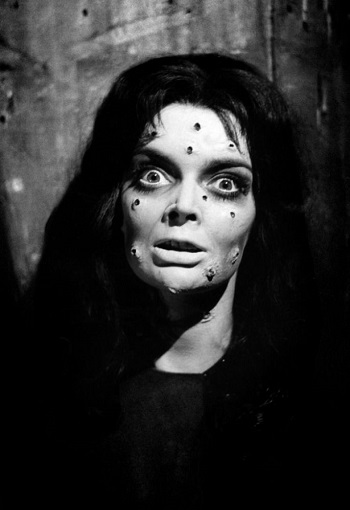Black Sunday (1961)
Sometimes Satan, with his capacity for doing evil, even plays tricks with the dead.

After following in his father’s footsteps, cinematographer Mario Bava made his directorial debut with 1960 gothic horror, Black Sunday, aka, The Mask of Satan, about a witch named Asa Vajda from Moldavia, who vows revenge after she and her apprentice are condemned to death by her brother, the crown prince. Two centuries later, on Black Sunday, the day Satan walks the earth, a traveling physician and his assistant unwittingly bring the witch back to life. After turning her apprentice into a vampire, Asa immediately sets out to fulfill her cursed prophecy, by terrorizing her brother’s descendants.
Production started in late March 1960 and took less than two months to film, releasing in Italy in August of 1960. The film was a modest success, bringing in $140 million lire, earning back its production costs, but performed much better in Europe and the US. Despite being low-budget, Black Sunday was praised for its originality and vivid imagery, however, the gore and gruesome violence shown in the film drew much criticism and was even banned in the UK until 1968, when a heavily censored version, retitled as Revenge of the Vampire, was finally released. The uncut version wouldn’t be shown until 1992!
In the US, Black Sunday was shown as a double feature with Roger Corman’s The Little Shop of Horrors in February 1961. In order to make the film less objectionable, American censors edited the movie down three minutes, excluding such violent scenes as, the burning and branding of flesh, eyeball impalement, and blood spewing out from the mask as it was hammered onto witch’s face in the opening sequence.
Unknown British actress Barbara Steele was cast in the lead duel role of the evil witch vampire Asa and her innocent descendant Katia. Even though her voice was dubbed by another actress, audiences swooned over Steele’s haunting beauty and loved her villainous portrayal of the vengeful Asa. Barbara Steele reportedly had a hard time on set and gained reputation for being difficult, mostly due in part to the lack of communication and language barrier.

What was once shocking to audiences of the early sixties, holds the same magic to influence numerous artists and filmmakers over the years, including Francis Ford Coppola, who is said to have recreated several scenes in Bram Stoker’s Dracula, as a homage to Bava, and Tim Burton’s Sleepy Hollow, which borrowed imagery, namely, the iconic death by iron maiden scene. The horrifying story of revenge and all its extreme violence and sexual suggestions actually helped Black Sunday become a cult classic.









You must be logged in to post a comment.